Bob Mayer's Blog, page 46
March 10, 2020
Five Differences Between SARS-CoV-2 (Coronavirus) and the Flu
This is based on recent observations, mostly from China, and medical journals, and is ongoing, but these appear to be trends:

Coronavirus spreads slower than the flu. Flu has a shorter incubation period and a shorter serial interval. Incubation period is the time it takes an infected person to show symptoms. Serial interval is the time between successive cases; for SARS-CoV-2 it is five to six days while for the flu it averages three days. That is why the flu spreads faster,For some reason we don’t know yet, children who are well known for spreading the flu (every time I visit the grandkids I pick up some crud, usually via their daycare) are less likely to spread SARS-CoV-2 than adults, It might be because their immune system is already heavily immunized against the common cold (which is a Cornovirus form but not a SARS). Or they might simply have better immune systems that react faster.SARS-CoV-2 is has a much higher mortality rate than the flu. People who keep posting about how many more dead from the flu than coronavirus are spreading a form of misinformation as we are in the early stage of what is very likely going to be a pandemic. Flu mortality is .1%. Right now, SARS-CoV-2 is roughly 3 to 4%.Secondary infections. The flu occasionally leads to secondary infections. But SARS-CoV-2 infected average 2 secondary infection, which is mainly why it is so deadly. The primary one is pneunomia.There is no cure or vaccine for SARS-CoV-2. There is a flu vaccine.
More to come as we learn more. But being educated is the best defense. Wash your hands. Don’t touch your face. Use Live Long and Prosper rather than hugs or handshakes.
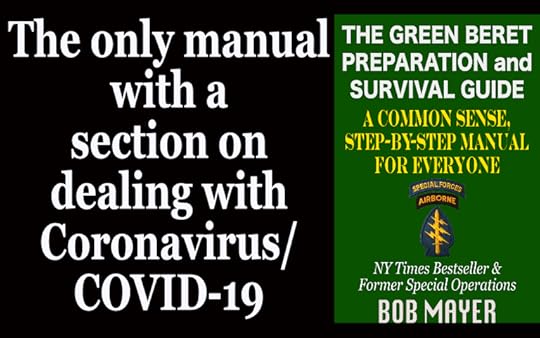
March 9, 2020
The Difference Between Symptoms of Coronavirus, the common Cold and the Flu
According to the World Health Organization, the chart below shows the differences between all three. Remember, though, each can manifest differently in different people, but it’s a base to use.

Wash your hands. Isolate as much as possible. Be smart. Be safe!
The Green Beret Preparation and Survival Guide, now updated with an appendix specific to SARS-CoV-2, aka coronavirus. If cost is prohibitive, please email me at bob@bobmayer.com and I’ll send you a free PDF version.
March 8, 2020
“Not Your Usual Survival Book.”
This is a review that was left on The Green Beret Preparation and Survival Guide on Amazon and it hits exactly what I was aiming for with the book.
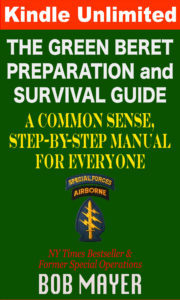
When I was surveying other books in the field (and my shelves are crammed with them) I realized they go from normal life to prepper life right from the start. They gloss over preparation for the events that will most likely happen, which as usually far short of the zombie apocalypse most fear. We will all suffer power outages, 80% of US Counties have suffered a weather disaster in the past decade. We drive cars and most likely will have a breakdown or accident in our lifetime (usually more than one).
I believe what makes Special Forces elite is our planning. When we went into isolation and did our Area Study and mission planing, we were meticulous and also focused on all the possible things that could go wrong and prepared for them. Preparation is the key! The first half of my book is focused on that, because you can’t prepare after the fact, as many people are learning even about basic things now with SARS-CoV-2, more commonly called Coronavirus, spreading. There’s panicked buying and a lot of basic items out of stock. If people are going to isolate in their home for a month, most are unprepared. Many of us don’t even know what we would need.
What I did when I wrote this book was to start from zero and, step by step, guide someone through preparing properly. For example, the Area Study. Every person/family’s situation is different so we all have to prepare differently. An Area Study is what we did before going on a mission– it makes sense to do one for yourself, where you are located, where your job is, etcetera.
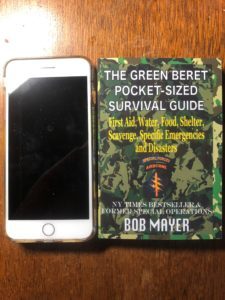
The second half of the book is the standard survival information, broken down by man-made and natural disasters. I just added an appendix about the SARS-CoV-2 virus.
I broke the survival portion out and put in a smaller, pocket-sized book that people can pack in their car, kitchen drawer, grab-n-go bag, etcetera.
Bottom line? I wrote this book for everyday people, not hard core preppers.
Of the other books I surveyed, there are two I also recommend. The SAS Survival Guide is good for being out in the field. Lots of pictures of various flora and fauna. And When Technology Fails is good for when, well, what it says.
March 6, 2020
Myths Busted and Truths about SARS-CoV-2/COVID-19/Coronavirus
Yes, SARS-CoV-2, is the official name of this form of Coronavirus. I think people don’t want to use the SARS term as it stands for Severe Acute Respiratory Syndrome. Scary right? Well, there are reasons to be afraid of this virus, but fear should be tempered with knowledge. So, here are myths busted and truths about this virus so you know what’s going on.
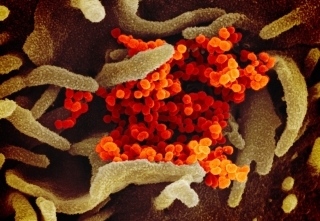 SARS-CoV-2 is the orange
SARS-CoV-2 is the orangeMyth: the rate of infection is low in the United States.
Truth: The data in the United States is skewed compared to other countries for a simple reason: as of 3 March we had only 43 reported cases which sounds good. But we’d only tested 500 people. The number of infected will go up precipitously as we test more people.
Myth: Standard surgical masks prevent you from getting the virus.
Truth: Standard surgical masks do not block viral particles or fit flush to the face. People who know or are afraid they are infected should wear masks, but then they should also be isolated, not out in public. Health care workers wear N95 respirators which do reduce the spread; but they are trained on them and they fit so that no air can get in around the edges, much like our gas masks in the army. Anyone who has ever entered the tear gas tent knows how important a proper seal is.
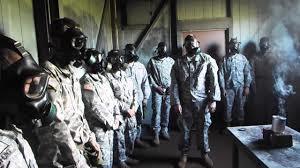
Myth: You’re more likely to get the flu.
Truth: The numbers are still coming in (note above about the skewed
number in the US), but spread is calculated with a ‘basic reproduction number’.
This is the number of people who can catch it from an infected individual. For
flu this is 1.3. For Coronavirus it is 2.2. Higher.
Myth: If you getCOVID-19 you’ll die.
Truth: Not likely. Currently, the mortality rate is 2.3%. That number
is full of people who already had respiratory problems and the elderly. 4.7% of
people end up in critical condition. 13.8% have severe illness. And 81% have a mild
case—but are contagious. This is the dangerous part.
Myth: Your dog can give it to you.
Truth: This is unlikely with no solid evidence to support. There was
a case in China of a dog that got a low-level infection from its owner who had
COVID-19. That means dogs can get it from people. But there is no evidence that
the opposite is true.
Myth: If you’re infected, you’ll know it.
Truth: During the early stage of infection you’ll exhibit no symptoms
(asymptomatic). This is what makes it so dangerous. There are people walking
around who are asymptomatic. Which is why we need a test. As of Friday 6 March,
the promised million kits have not been distributed. There have been 75,000
sent out.
Myth: SARS-CoV-2 is a form of the common cold.
Truth: Four other types of Coronaviruses do cause the common cold. But
not this one. SARS-CoV-2 is a combination of several viruses. It’s a coronavirus
in that it has spiky projections on its surface and uses those to infect the
host. But while humans are hosts for those other four Coronaviruses, SARS-CoV-2
shares 90% of its genetic materials with bats, which indicates it most likely
originated in bats and then jumped to humans.
Myth: I can get SARS-CoV-2 opening a package from China.
Truth: No, it won’t last that long in transit. I’ve explained how
long SARS-CoV-2 can last on surfaces in another post. Conditions vary
that but a package’s temperature in transit, lack of UV exposure and humidity
all make that unlikely. There are no known cases of this.
Myth: You can get SARS-CoV-2 from a Chinese restaurant.
Truth: No. Nor can you get it from drinking Corona beer, even though
1/3rd of beer drinkers surveyed said they were afraid of that.
And that brings us to the point: know the truth. Take the proper precautions. Primarily washing hands and avoiding hand to face unless you have clean hands. There are more in other posts and in a special Appendix added to The Green Beret Preparation and Survival Guide.
March 4, 2020
As of 4 March 2020. What is Coronavirus ? How does it spread? What should you do to prevent exposure? What about a vaccine?
There’s a Good Chance We Will Be Exposed to the Coronavirus.
Caveat: I am not a doctor and just referring to the information
I have researched.
Why is it likely? Because the unique combination of how long a
person can be infected before it manifests itself and the fact we have no
vaccine for it and won’t have one soon. Also, even with a vaccine, it won’t go
away. It will become something else we need to get a shot for every year. Once
the shot is invented.
Don’t panic, though. You might be asymptomatic (show no symptoms). You may develop mild symptoms and be fine. You might get sick but the odds are you will get through it. The mortality rate is very low. As far as we know right now.
There are two factors to consider: the odds of getting it, and
then the odds that it will be fatal. Again, don’t panic. Read and become
educated on it. I’ll explain as best I can using the latest information as of 2
March 2020.
Background:
Right now, the World Health Organization estimates that Coronavirus has a 3.4% mortality rate. This is higher than the estimate just four days ago. But because it is slow to manifest itself, people who have it show no symptoms and can spread it. This is the danger of Coronavirus: it is deadly, but not overly deadly. A perfect storm of virus. People are testing positive for it without showing any symptoms. Which means it’s spreading right now and we can’t tell how fast and how far.
How does it spread?
The Coronavirus is not airborne like measles or smallpox. It is spread through droplets. This means it is spread by contact with those droplets. It only infects the lungs.
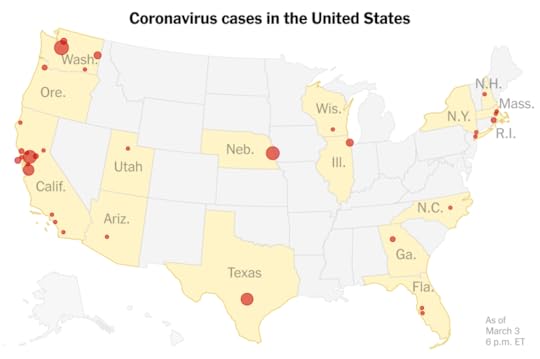
Thus, someone sneezing can spread it several feet around them when sneezing. Use six feet as your blast radius. If you’re sitting on a plane and someone sneezes and doesn’t cover it up, that is the distance they are spreading it, give or take. Not just on you, but on all surfaces around them.
While your mask might protect you from inhaling a droplet, it
can still get on you (and the mask so you can put the virus on your hands if
you touch it or when you take it off) and then in you via contact by your hand
with your nose or mouth.
How long does it last on a surface? This is the most dangerous part you have to factor in to
everything you do.
While much isn’t known right now, here are the best estimates:
Depending on the material and the conditions, human coronaviruses can remain
infectious from 2 hours to 9 days on a surface. At temperatures of around 4°C
or 39°F, certain versions of the coronavirus could remain viable for up to 28
days. At temperatures of 30–40°C (86–104°F), coronaviruses tended to persist
for a shorter time. High humidity also helps it hang around. This is not good.
At room temperature, a coronavirus responsible for the common
cold (HCoV-229E) persisted significantly longer in 50% humidity than 30%
humidity. For working purposes: Human coronaviruses can remain infectious on
inanimate surfaces at room temperature for up to 9 days. At a temperature
of 30°C [86°F] or more, the duration of persistence is shorter. Veterinary
coronaviruses have been shown to persist even longer for 28 days.
The bottom line is that there are variables in how long the
Coronavirus will be viable on various surfaces in varying environments.
Anywhere from several hours, to weeks. We should know more as more research is
done.
But consider the problem this presents. Anything you touch might
have the virus on it. One thing I’ve thought of is Amazon Prime. Think of the
number of people who touch the product and the box before it gets to your doorstep?
The newspaper I get out of the mailbox each morning? This is why the spread
will be so large.
To disinfect for Coronavirus:
Hydrogen peroxide (.5%) or bleach (.1%) appears to work. Chlorhexidine
digluconate, often used as antiseptic, is not effective. Use hand sanitizer
with better than 60% alcohol based. Keep a bottle by every entrance to your
house. Keep it in your car. Use after contacting any possibly contaminated
surfaces.
Containment:
The first goal to prevent a pandemic is containment. While there
is a chance Coronavirus will be contained, it grows less likely each day as
more cases pop up around the world. Particularly when we see it in people who
have not traveled to a contaminated area or, as far as can be determined, have
not had contact with someone who has. The virus, as of 27 February 2020, is in
forty countries. Just a few days ago that number was twenty-four.
Coronavirus has developed in people who were asymptomatic. Thus,
people who appear and test normal, are spreading it. Some epidemiologists
believe that within a year, forty to seventy percent of the people around the
world will be exposed to Coronavirus. Many will be asymptomatic and fine. Some
will have mild symptoms and turn out all right. Those with chronic health
problems and the old are the most at risk of serious complications from it. It
is a virus that causes a respiratory illness.
What are the Symptoms?
Coronavirus causes pneumonia. If infected, you’ll suffer cough, fever
and difficulty breathing. If its severe, there can be organ failure. Because it’s
a viral pneumonia, antibiotics are not useful. Ultimately recovery depends on
the strength of a person’s immune system.
The majority of those who have died had weakened immune systems
or were in poor health to begin with. Heavy smokers are at risk.
How do you protect yourself?
Wash your hands constantly.
You can get it from touching a surface with droplets on it. It persists on
surfaces longer in colder, more humid environments. Using soap and water or an alcohol-based
hand kills the virus that may be on your hands. Dry your hands on a paper towel
you don’t reuse rather than a cloth towel or use an air dry.
When you wash, do it for 10 to 20
seconds. I’ve seen people ridiculing videos and instructions on-line about ‘how
to wash your hands’, since they think that’s a simple skill they learned as a
child. Take your cell phone. Go to the timer. Set it for 20 seconds. Run it.
Never knew 20 seconds was that long, eh? A nurse told me he was taught to
silently sing “Happy Birthday” to himself three times and that was long enough.
Wash your hands constantly. When caring
for the sick. Before, during and after preparing a meal. Before eating. After
toilet use. When hands are dirty. After handling animals or animal waste.
Hands: Don’t shake hands. Use your
knuckles to turn on light switches, use elevator buttons, etc. Use a paper
towel or have gloves on when getting gas. Wear disposable latex gloves when going
out, remembering to not touch your face. Dispose of when entering your home.
Masks? Their effectiveness is debatable
and I see arguments on both sides. The CDC doesn’t recommend that healthy
people wear one. Most people don’t know how to use one properly; they might not
fit well; most dangerously, they can give a false sense of security. Use a mask
if you are caring for someone who is sick. A positive of a mask is to remind
you not to touch your face. An infected person should definitely be masked. If
masked it must cover both mouth and nose.
Gloves: Use disposable latex gloves when
coming in contact with surfaces that could be contaminated. Remember, they will
be contaminated then, but if you don’t touch your face and discard them then
wash your hands, it’s a plus.
Avoid touching your nose and mouth.
If the virus is on
your hands, and you touch either of those, that is how it enters your body. If
you touch food or drink with contaminated hands and then consume it, it can
enter that way.
Practice respiratory hygiene. This sounds fancy but it means
covering your mouth with your bent elbow (not your hand) or a tissue when you
sneeze. Dispose of the tissue.
Avoid close contact with others. This is called keeping social
distancing. Keep at least 3 feet, especially if someone is coughing or
sneezing. Don’t shake hands or hug others.
If you have fever, cough and
difficulty breathing, seek medical care early. Call your health provider and find out where you
should go.
Zinc lozenges:
These have some effectiveness if you use them as scheduled. Lie on your
back while you let it dissolve so it gets to the back of your throat and
nasopharynx.
Stay informed and follow advice. This is an ongoing and fluid
situation, so keep up to date with the latest. One report I saw indicated that
it is possible to get COVID-19 again, after it clears up. I don’t know if that’s
true or not, so stay up to speed.
Practice food safety. Use different chopping boards and
knives for raw meat and cooked foods. Wash your hands when switching between
handling the two.
Protect others from getting sick. If you have fever, cough or
difficulty breathing, isolate yourself and seek medical attention. Don’t go to
work or school and spread it.
Traveling? Avoid it as much as you can.
Avoid nonessential travel. Avoid cruises.
Preparation:
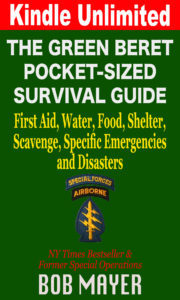
While you should be prepared at a basic level as indicated in my Green Beret Preparation and Survival Guide, there are things you can do now. Consider how you’d prepare if there was a snowstorm in your area. Stock your cupboards with additional food. Canned coup, beans, pasta, rice are good examples. Consider having enough on hand to last several weeks. This is covered in detail under Food in the preparation portion of that book.
Make sure you have aspirin or
ibuprofen on hand.
If you take prescription medicine
have as much on hand as you can.
Consider if you have to home
school. Japan has already closed schools to reopen later in the year.
Consider if you can work from home.
The Vaccine:
Scientists are already at work on vaccines because the Chinese,
once they identified it, sent the data to other scientists around the world.
Making vaccines is difficult. Researchers have to copy the
virus’s RNA, which is happening right now. Then the hard part: finding a viral
sequence that will cause a protective reaction from the body, but not an acute
one that will cause problems of its own. That fine tipping point is difficult
to find. It requires considerable testing or else the solution might be as bad
as the problem.
The best estimates are 12 to 18 months to a vaccine. Even then,
manufacture and distribution will take time. Thus, the next year will be
critical. There are other complications. What if manufacture requires an intact
supply chain and the pandemic has broken that chain? What if one country comes
up with a vaccine but closes its borders until all its citizens are vaccinated?
A large problem is that governments and particularly private
industry, have been unwilling to invest large amounts of money and time into
developing the capability to invent vaccines when there is no urgent threat.
But once there is an urgent threat, it takes time to spin up the mechanism to
do so. The United States recently went backwards in this regard with cuts to
various agencies that research and deal with the possibility of pandemics. It
is not something that can spin up at full speed since they’ve been shuttered.
Also, research needs to be ongoing.
What is a Pandemic?
A pandemic is an epidemic of infectious disease that spreads
across a large region; usually multiple continents. Some of this information
replicates the material for COVID-19, but there is the probability of different
pandemics in the future.
Experts believe the odds of a pandemic within the next fifty
years are very high. Estimates are that: 1 billion people would get sick. 165
million will die There will be a global recession and depression. If you do the
percentage, that’s a 1.65% mortality rate. Currently, it’s estimated that
coronavirus has a mortality rate of under 2%
Why are the odds of a pandemic high?
1. Global population has increased dramatically.
2. People are moving to crowded, central locations: cities.
3. World-wide travel is much faster and more common.
If it’s a true pandemic, it’s not likely that a hospital is a place to go as it will quickly become overwhelmed with the sick and dying. The bottom line is to stay aware and isolate yourself and your team as quickly as possible.
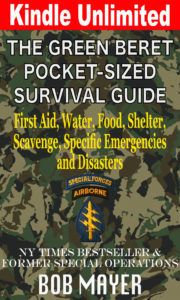
The problem is that the spread of Coronavirus won’t be
instantaneous and burn out just as quickly. If your area is seeing cases it
would be prudent to isolate for a month, but it will probably take longer for
the virus to pass. That is why the chances of contracting it are high. This
isn’t being alarmist, but realistic.
I hope I am wrong about all of this. Nothing I’ve written about
is locked down. There are many variables. but I’ve found it best to be knowledgeable
and realistic about possibilities.
March 3, 2020
The Advantage of Indie Publishing: Speed & Coronavirus
I’ve had a new version of The Green Beret Preparation and Survival Guide out for some months now. But given recent events, I wanted to beef up the section I already had on Pandemics with information on the Coronavirus (COVID-19) So I wrote a section, added it to not only that book, but the Green Beret Pocket-Sized Survival Guide on 29 Feb, and uploaded.

Then I learned one or two new things, such as how to use gloves and taking zinc tablets and added those on 2 March.
Both books, both print and ebook versions, are now live with the very latest.
Which allowed me to do a blog post yesterday afternoon with the excerpt and also get information out there.
This is the advantage of being an indie publishers and understanding all aspects of publishing, from the idea for a book, through writing it, outsourcing editing and covers, formatting, uploading and promoting. All in an hour or so.
That is the advantage of the internet. This is not only for eBooks, but print-on-demand allows me to update my print books at the same pace.
I’ve been writing and publishing for three decades. I’ve seen all aspects of it from traditional to indie to hybrid to publishing with Amazon Imprint. I ran my own publishing company for a while, Cool Gus, and learned a lot from the other side of the desk. The learning curve is steep. I’m still learning. For example, I’m spending more and more time with Amazon Marketing Services, adjusting my targets and ad on an almost daily basis. Gone are the days of writing the manuscript and shipping it off to the publisher.
Being an author, regardless of platform, is a dynamic process, not static. The core of it, the writing is eternal. The mode to get that writing to the consumer, the reader, is ever-changing.
March 1, 2020
How To Deal With the Coronavirus (COVID-19) Outbreak.
What makes Special Forces elite is our training and, most importantly, our planning. Before going on a mission, we would conduct “Isolation” where we would be in a secure compound and plan our mission. We’d conduct an Area Study, which focused on the Area of Operations where we would be doing the mission. We’d plan the mission from infiltration, actions on the objective, through exfiltration. Key was war-gaming what could go wrong. We’d try to think of every possible contingency using Murphy’s Law: What can go wrong, will.
With that in mind, given I’ve already written The Green Beret Preparation and Survival Guide based on my training, deployment experiences, and having taught at the JFK Special Warfare Center & School at Fort Bragg for a number of years and it included a section on pandemics, I’ve added the same Appendix to both it, and the Pocket-Sized Survival Guide (smaller and compact without the preparation part), focused specifically on COVID-19, the Coronavirus.
There’s a Good Chance
We Will Be Exposed to the Coronavirus.
Why is it likely? Because the unique combination of how long a
person can be infected before it manifests itself and the fact we have no
vaccine for it and won’t have one soon. Also, even with a vaccine, it won’t go
away. It will become something else we need to get a shot for every year. Once
the shot is invented.
Don’t panic, though. You might be asymptomatic (show no symptoms).
You may develop mild symptoms and be fine. You might get sick but the odds are
you will get through it. The mortality rate is very low.
There are two factors to consider: the odds of getting it, and then the odds that it will be fatal. Again, don’t panic. Read and become educated on it. I’ll explain as best I can using the latest information as of 29 February 2020.

Background:
When Avian Flu broke out in 1997, it was something that had been
seen before, but only in birds. When the first human fatality occurred,
authorities acted swiftly. Initially, 18 cases were identified. 6 people died.
In the last two decades Avian Flu has killed 455 people. The reason the number
is low is because this flu is so deadly. It presents itself quickly, before it
can spread. It has a roughly 60% mortality rate. The ‘regular’ flu has less
than a .1% mortality rate. Yet it kills hundreds of thousands of people every
year. Why? Because it can spread before showing symptoms and thus more people
get it. This is why it is likely we will be exposed to COVID-19.
Right now, it’s estimated that Coronavirus has less than a 2%
mortality rate. But because it is slow to manifest itself, people who have it
show no symptoms and can spread it. This is the danger of Coronavirus: it is
deadly, but not overly deadly. A perfect storm of virus. People are testing
positive for it without showing any symptoms. Which means it’s spreading right
now and we can’t tell how fast and how far.
How does it spread?
The Coronavirus is not believed to be airborne like measles or smallpox. It is spread through droplets. This means it is spread by contact.

Thus, someone sneezing can spread it several feet around them
when sneezing. Use six feet as your blast radius. If you’re sitting on a plane
and someone sneezes and doesn’t cover it up, that is the distance they are
spreading it, give or take.
While your mask might protect you from inhaling a droplet, it
can still get on you (and the mask so you can put the virus on your hands if
you touch it or when you take it off) and then in you via contact by your hand
with your eyes, nose or mouth.
How long does it last on a surface? This is the most dangerous part you have to factor in to
everything you do.
While much isn’t known right now, here are the best estimates:
Depending on the material and the conditions, human coronaviruses can remain
infectious from 2 hours to 9 days on a sruface. At temperatures of around 4°C
or 39°F, certain versions of the coronavirus could remain viable for up to 28
days. At temperatures of 30–40°C (86–104°F), coronaviruses tended to persist
for a shorter time. High humidity also helps it hang around. This is not good.
At room temperature, a coronavirus responsible for the common
cold (HCoV-229E) persisted significantly longer in 50% humidity than 30%
humidity. For working purposes: Human coronaviruses can remain infectious on
inanimate surfaces at room temperature for up to 9 days. At a temperature
of 30°C [86°F] or more, the duration of persistence is shorter. Veterinary
coronaviruses have been shown to persist even longer for 28 days.
The bottom line is that there are variables in how long the
Coronavirus will be viable on various surfaces in varying environments.
Anywhere from several hours, to weeks. We should know more as more research is
done.
But consider the problem this presents. Anything you touch might
have the virus on it. One thing I’ve thought of is Amazon Prime. Think of the
number of people who touch the product and the box before it gets to your doorstep?
The newspaper I get out of the mailbox each morning? This is why the spread
will be so large.
To disinfect for Coronavirus:
Hydrogen peroxide (.5%) or bleach (.1%) appears to work. Chlorhexidine
digluconate, often used as antiseptic, is not effective. I am not a doctor and
just referring to the information I have have researched. Pandemic
Containment:
The first goal to prevent a pandemic is containment. While there is a chance Coronavirus will be contained, it grows less likely each day as more cases pop up around the world. Particularly when we see it in people who have not traveled to a contaminated area or, as far as can be determined, have not had contact with someone who has. The virus, as of 27 February 2020, is in forty countries. Just a few days ago that number was twenty-four.

Coronavirus has developed in people who were asymptomatic. Thus,
people who appear and test normal, are spreading it. Some epidemiologists
believe that within a year, forty to seventy percent of the people around the
world will be exposed to Coronavirus. Many will be asymptomatic and fine. Some
will have mild symptoms and turn out all right. Those with chronic health
problems and the old are the most at risk of serious complications from it. It
is a virus that causes a respiratory illness.
What are the Symptoms?
Coronavirus causes pneumonia. If infected, you’ll suffer cough, fever
and difficult breathing. If its severe, there can be organ failure. Because it’s
a viral pneumonia, antibiotics are not useful. Flu antivirals also don’t work.
Ultimately recovery depends on the strength of a person’s immune system.
The majority of those who have died had weakened immune systems
or were in poor health to begin with. Heavy smokers are at risk.
How do you protect yourself?
Wash your hands constantly.
Also, you can get it from touching a surface with droplets on it. It’s unknown
how long Coronavirus remains active outside the body, which is part of the
problem. It persists longer in colder, more humid environments. Using soap and water or an alcohol-based
hand kills the virus that may be on your hands. Dry your hands on a paper towel
you don’t reuse rather than a cloth towel or use an air dry.
When you wash, do it for 20
seconds. I’ve seen people ridiculing videos and instructions on-line about ‘how
to wash your hands’, since they think that’s a simple skill they learned as a
child. Take your cell phone. Go to the timer. Set it for 20 seconds. Run it.
Never knew 20 seconds was that long, eh? A nurse told me he was taught to
silently sing “Happy Birthday” to himself three times and that was long enough.
As a kid in the Bronx, when we played touch football in the street we’d go “One-Mississippi-Two-Mississippi-Three-Mississippi”
etcetera before we could rush the quarterback.
Wash your hands constantly. When caring
for the sick. Before, during and after preparing a meal. Before eating. After
toilet use. When hands are dirty. After handling animals or animal waste.
Masks? Their effectiveness is debatable
and I see arguments on both sides. The CDC doesn’t recommend that healthy
people wear one. Most people don’t know how to use one properly; they might not
fit well; most dangerously, they can give a false sense of security. Use a mask
if you are caring for someone who is sick.
Avoid touching your eyes, nose and
mouth. If the
virus is on your hands, and you touch any of those, that is how it enters your
body.
Practice respiratory hygiene. This sounds fancy but it means
covering your mouth with your bent elbow (not your hand) or a tissue when you
sneeze. Dispose of the tissue.
Avoid close contact with others. This is called keeping social
distancing. Keep at least 3 feet, especially if someone is coughing or
sneezing. Don’t shake hands or hug others.
If you have fever, cough and
difficulty breathing, seek medical care early. Call your health provider and find out where you
should go.
Stay informed and follow advice. This is an ongoing and fluid
situation, so keep up to date with the latest. One report I saw indicated that
it is possible to get COVID-19 again, after it clears up. I don’t know if that’s
true or not, so stay up to speed.
Practice food safety. Use different chopping boards and
knives for raw meat and cooked foods. Wash your hands when switching between
handling the two.
Protect others from getting sick. If you have fever, cough or
difficulty breathing, isolate yourself and seek medical attention. Don’t go to
work or school and spread it.
Traveling? Avoid it as much as you can.
Avoid nonessential travel. Avoid cruises.
Preparation:
While you should be prepared at a
basic level as indicated in my Green Beret Preparation and Survival Guide,
there are things you can do now. Consider how you’d prepare if there was a
snowstorm in your area. Stock your cupboards with additional food. Canned coup,
beans, pasta, rice are good examples. Consider having enough on hand to last
several weeks. This is covered in detail under Food in the preparation of that
book.
Make sure you have aspirin or
ibuprofen on hand.
If you take prescription medicine
have as much on hand as you can.
Consider if you have to home
school. Japan has already closed schools to reopen later in the year.
Consider if you can work from home.
The Vaccine:
Scientists are already at work on vaccines because the Chinese,
once they identified it, sent the data to other scientists around the world.
Making vaccines is difficult. Researchers have to copy the
virus’s RNA, which is happening right now. Then the hard part: finding a viral
sequence that will cause a protective reaction from the body, but not an acute
one that will cause problems of its own. That fine tipping point is difficult
to find. It requires considerable testing or else the solution might be as bad
as the problem.
The best estimates are 12 to 18 months to a vaccine. Even then,
manufacture and distribution will take time. Thus, the next year will be
critical. There are other complications. What if manufacture requires an intact
supply chain and the pandemic has broken that chain? What if one country comes
up with a vaccine but closes its borders until all its citizens are vaccinated?
A large problem is that governments and particularly private
industry, have been unwilling to invest large amounts of money and time into
developing the capability to invent vaccines when there is no urgent threat.
But once there is an urgent threat, it takes time to spin up the mechanism to
do so. The United States recently went backwards in this regard with cuts to
various agencies that research and deal with the possibility of pandemics. It
is not something that can spin up at full speed since they’ve been shuttered.
Also, research needs to be ongoing.
What is a Pandemic?
A pandemic is an epidemic of infectious disease that spreads
across a large region; usually multiple continents. Some of this information
replicates the material for COVID-19, but there is the probability of different
pandemics in the future.
Experts believe the odds of a pandemic within the next fifty
years are very high. Estimates are that: 1 billion people would get sick. 165
million will die There will be a global recession and depression. If you do the
percentage, that’s a 1.65% mortality rate. Currently, it’s estimated that
coronavirus has a mortality rate of under 2%
Why are the odds of a pandemic high?
1. Global population has increased dramatically.
2. People are moving to crowded, central locations: cities.
3. World-wide travel is much faster and more common.
If it’s a true pandemic, it’s not likely that a hospital is a
place to go as it will quickly become overwhelmed with the sick and dying. The
bottom line is to stay aware and isolate yourself and your team as quickly as
possible.
The problem is that the spread of Coronavirus won’t be
instantaneous and burn out just as quickly. If your area is seeing cases it
would be prudent to isolate for a month, but it will probably take longer for
the virus to pass. That is why the chances of contracting it are high. This
isn’t being alarmist, but realistic.
I hope I am wrong about all of this. Nothing I’ve written about is locked down. There are many variables. but I’ve found it best to be knowledgeable and realistic about possibilities.
For those who might find getting the Preparation and Survival Guide financially difficult, I’ll be glad to send you a pdf version via email at bob@bobmayer.com
The Green Beret Preparation and Survival Guide and The Green Beret Pocket-Sized Survival Guide.
February 28, 2020
Odds are, we will get Coronavirus
Researching available data, I’ve summarized the information in this free slideshow. I’m not a doctor or scientist, just a practical person. In Special Forces what made us “special” was our planning. We always did an Area Study of our potential Area of Operations. Then we planned for all contingencies we could think of, worst-casing the scenario.
I think this slideshow is a reasonable portrait of the issue. I didn’t get into worst case scenarios, just an explanation of where things stand now and, most importantly, what Coronavirus (technically what we’re concerned with is called COVID-19) is. Knowledge is power.
What We Need to know about the Coronavirus from Bob Mayer
February 27, 2020
Why Prepare Now? Because . . .
It’s too late to prepare after a disaster or emergency strikes.
People are finding this out now as they realize they can’t buy facemasks, either in the store or online.
In the free slideshow below, I give the facts and figures that should wake people up. I hope.
Why Prepare Now? Because you can't after the fact. from Bob Mayer
February 24, 2020
Preparing for the Coronavirus

There’s considerable disinformation and confusion about the extent of the virus. Some of it is deliberate propaganda. Some of it is exaggeration. Nevertheless, the virus is spreading and the infected and death toll is rising.
I just checked on Amazon and face masks are sold out. Take a look in your local pharmacy at the shelves to get an idea how your neighborhood is reacting. I just went downstairs to our in-house cache and retrieved several masks that were part of my preparation.
Besides masks one of the basics of prevention sounds simple but is actually very important: wash your hands. Avoid contact with others as much as possible.

If there is a full blown pandemic (the definition is in the slideshow below) the best course of action is to hunker down and avoid all outside contact for a month. Are you prepared for that? I just ordered another bucket of Mountain House Meals as I’ve used some for camping (a way to rotate supply), although we have plenty on hand, more is never a bad idea. With sufficient food, and as long as your water supply is good, you could ride it out. On the very first page of The Green Beret Preparation and Survival Guide, Task #1 is to buy at least 2 cases of water per person in your household for emergencies. That’s a six day supply. But that’s for when your water supply is interrupted or contaminated. In a dire emergency you have a supply of water in your home you might not have thought of and I cover that further in the book.
Most people don’t understand the exact definition of a Pandemic and I also cover that and it’s in the slideshow.
The bottom line is this should be a wake up call to a lot of Americans. 60% of household are not prepared to even a base level for emergencies. Do you have a first aid kit? The 2 cases of water per? An emergency radio? A survival manual that lets you know what to do in an emergency?
Here is key information on preparing for and surviving a pandemic:
How to Prepare for and Survive the Inevitable Pandemic from Bob Mayer



